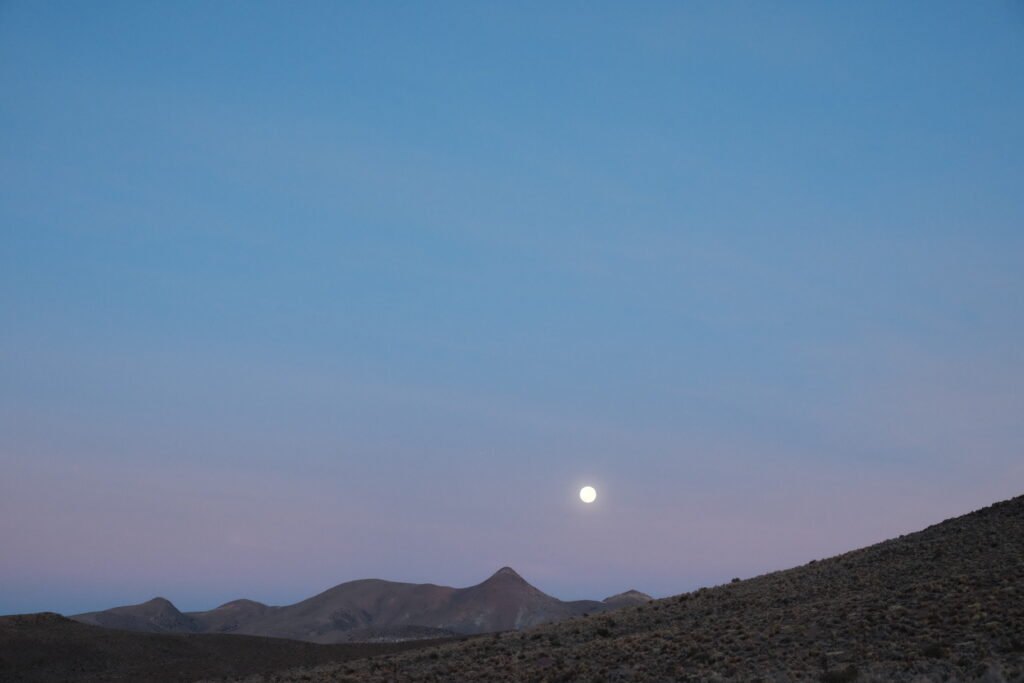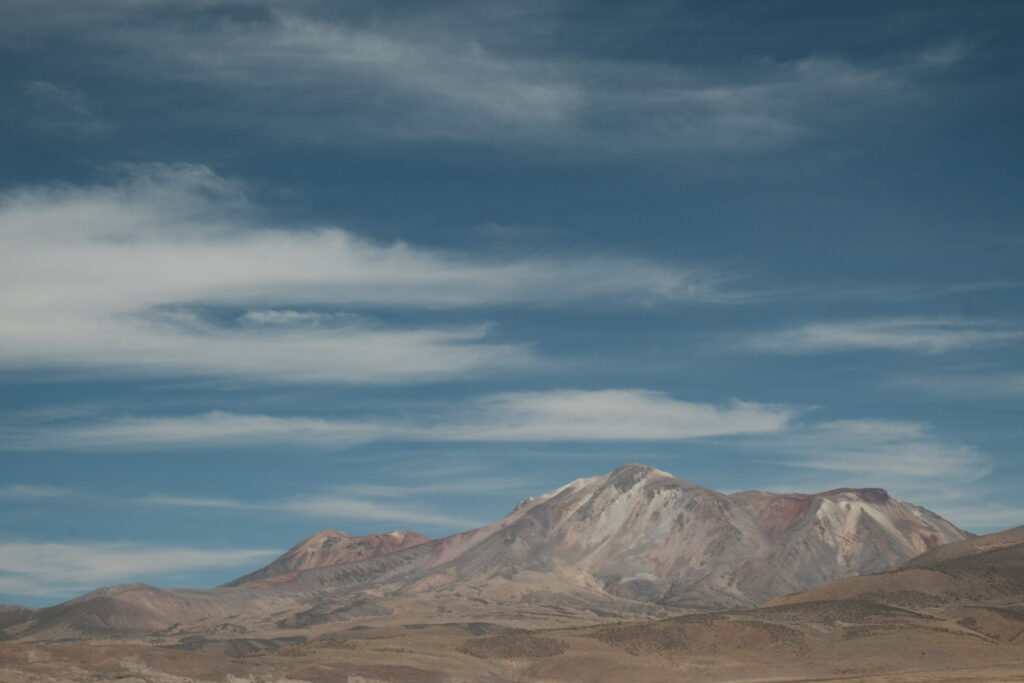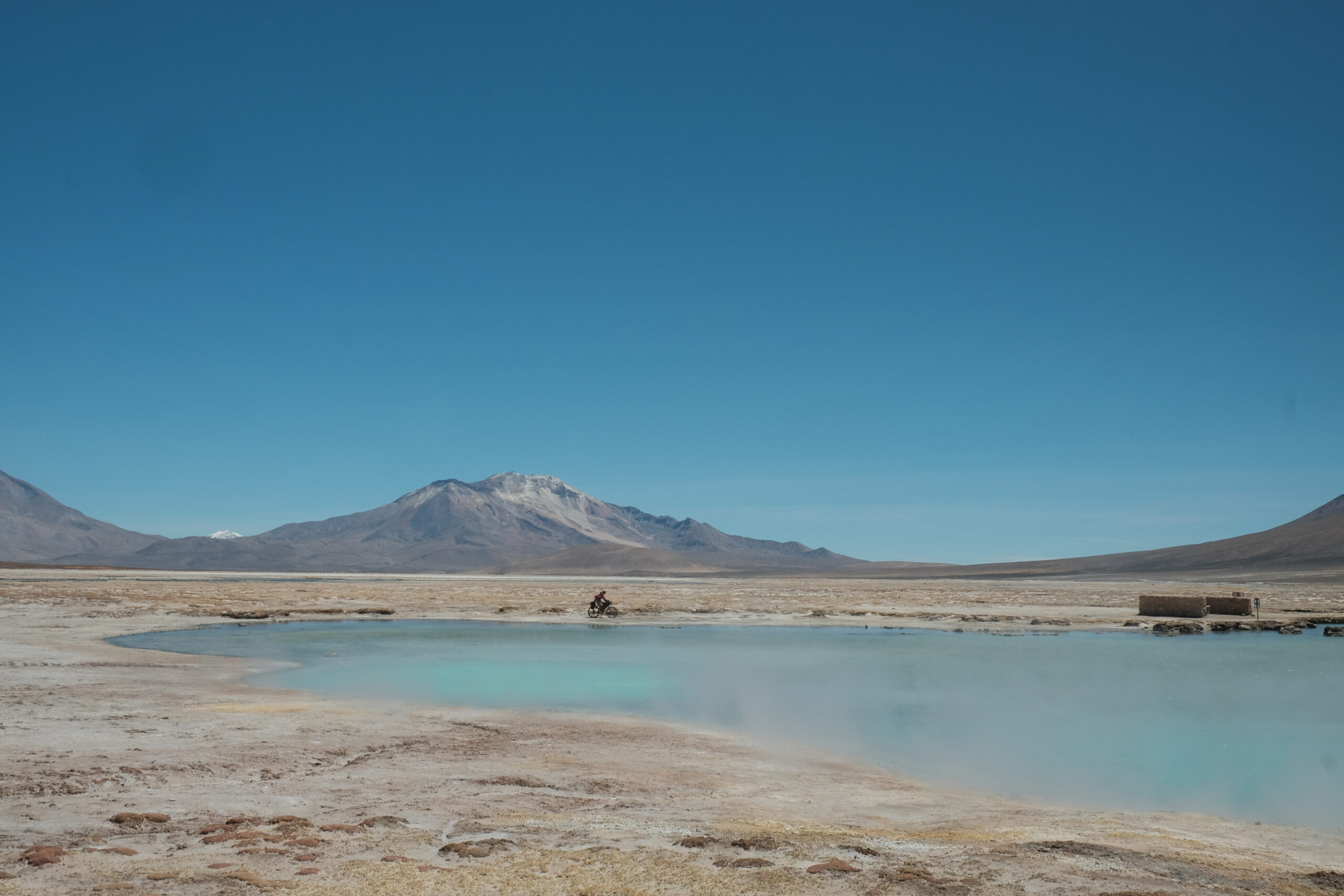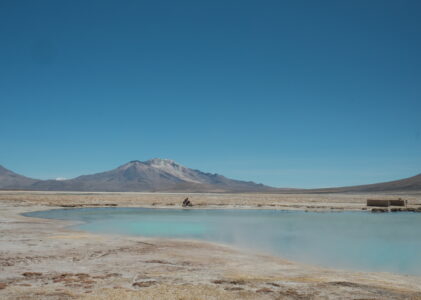This border region of Western Bolivia and North Eastern Chile is famous for many things. The unique combination of volcanoes, altiplano and salt flats mean it’s one of the most unusual habitats on Earth and a nature philic bike tourer’s paradise. We’d had Ruta de las Vicuñas put on our radar by Dan and Janie. We met the northbound Canadians in Oyon, Peru and they persuaded us it was worth dipping into Chile to follow the Vicuñas route before returning to Bolivia to ride across the famous Salar de Uyuni. The route is one of Cass Gilbert’s inventions, but deviates slightly from his more characteristically challenging creations; Ruta de las Vicuñas is remote yet straightforward, with an abundance of wildlife spotting opportunities, skinny dipping in hot springs and historical churches. While the official start is in the Chilean town of Putre, it made more sense for us to ride from Sajama and avoid descending 1,000m below the altiplano only to have to climb back up again. There is no resupply on route so it didn’t make a difference to how much food we have to carry and avoided the faff of having to source Chilean pesos. Joining the route from Sajama allowed us to explore more of Lauca National Park and added the Termas de Churiguaya to our itinerary, highly recommended!

It felt a bit odd, after close to 4 months in Peru we’d only spent a couple of weeks in Bolivia and we were already leaving! We would return, we reminded ourselves. From Sajama, we battled into a headwind all morning to reach the Chilean border control. Entering Chile is one of the more complicated border crossings in South America because of customs controls on plant based products and the requirement to register your bicycle as a vehicle. But first, we had to get our passports stamped. The receipts the border official gave us indicated that Liam had been processed as being of German nationality (clearly the Brexit blue passport doesn’t scream British as loudly as Boris hoped), and I was processed as being from the Republic of Ireland (The United Kingdom of Great Britain and Northern Ireland being too long to read and the border officials just zeroing in on the last word)! Thankfully, processing the bikes and doing the customs declaration was straight forward and we were allowed through with all our oats, peanut butter and coffee.

As we weren’t dropping down to Putre, we immediately turned left into Lauca National Park and were greeted with a flamboyance of flamingos flouncing around against an impressive backdrop of snow capped volcanoes. A few meters further along the dirt track, a herd of Vicuñas made us stop in our tracks and the movement of Rhea running caught our eyes, these grey-brown flightless birds otherwise camouflaged against the volcanic rock and sparse pampa.

The entire day had been spent bracing our bodies against the wind. No one understands a headwind quite like a cyclist. Not only does it slow your progress by blowing you backwards, but it also saps your energy from having to hold your arms, shoulders and neck like you’re being buffeted by a continuous, invisible wave. The noise in your ears wears you down mentally, so when we rolled past the Termas de Churiguaya we were ready to stop. Stepping inside the small hut and finally getting out of the wind, the constant roar in our ears finally silent, was bliss. Immersing our tired and tense bodies into the hot waters was glorious! With an indoor and outdoor pool filled by a geyser we felt spoiled. The indoor pool was incredibly hot, even for me, and I’m known for enjoying a good poach in a steaming bath! We were very happy we’d modified the route instead of facing a 1,000m climb out of Putre in the morning!




We slept inside the hut, describing it to friends from the UK as ‘a bothy with a hot tub’, assuming that a large mass of hot water would keep us relatively warm despite the simple construction. We were lucky, it was by far the coldest night of the trip so far, a water bottle left outside on my bike had frozen solid – the first time this has happened all trip. The too hot indoor pool had lost some of its ferocity overnight and was now a very pleasant temperature, so we warmed our bodies with a pre-breakfast soak (dirtbags who?!). Reluctantly leaving this remote spa with unprecedented levels of Zen, we rolled on to crunch through frozen streams excited at what the new day would bring.



The wind was less severe and we rolled into the small hamlet of Guallatire where there is the most beautifully preserved Jesuit mission church complete with working bell tower (I contorted my way up the tiny staircase to give it a ring), a tap and free Wi-Fi from the Chilean government! After connecting we received the truly excellent news that our friends Steph and Eric had welcomed their baby daughter into the world safely! While very happy news, it’s slightly bitter-sweet as a reminder at how many major life events we are missing out on while we experience this great adventure.





The roads that morning were smooth and fast rolling ‘thanks’ to the presence of a Boron mine on the Salar de Surire. While the trucks kicked up some dust, they were driven by the friendliest bunch and regular waves, llama and vicuña kept our spirits high until we found a nice spot by a small stream/puddle for our peanut butter and jam sandwiches.


As we crested a hill and got our first glimpse of the salt flats of the Salar de Surire with the pink bodies of flamingos contrasted against the flat brilliant white. Before heading off to our camp spot at an abandoned village, we stopped at the police outpost to fill up with water. We were greeted by the policeman’s very friendly pet llama, dressed in a rather dashing orange neckerchief he approached us for a good ear scratch. The police dog was a lot less friendly. Smuggling is common in this region as it’s such a remote part of the Chile/Bolivian border (if you were wondering why such a remote and beautiful location warranted a police station).


This was the first time we’d seen flamingos in these numbers and I was excited to hopefully see some close up. I can understand that these pink, spindly legged things look great in tropical themed prints and shirts but really, I think they’re suffering from a bit of an image problem. Flamingos are tough as nails, living in such a harsh environment with strong sun, temperatures down to -20C at night in winter and thriving on their spindly legs in the windy altiplano! Unfortunately, despite my flamingo fancying none of them wanted to come that close to me. We camped in an abandoned village at a view point on the shores of the Salar for some shelter and some front row flamingo seats. While Liam studied the information boards which explained how to identify the three different species based on the colour of their legs, beaks and irises, I borrowed the camera and did my best wildlife photographer impression with a woefully under powered lens.



In the morning we woke up to a glassy calm laguna. With the wind having died down completely overnight, the water mirroring perfect reflections of the mountains and flamingos. Sometimes I feel like I’m getting desensitised to the beauty of the Andes but this was a truly awe inspiring morning.



After riding around the Eastern side of the Salar on a road that got increasingly sandy and more washboarded, we arrived at our third thermal springs in three days – Termas de Polloquere. Barely recognisable by this point from our previous dirtbag identities and counting our lucky stars to be alone here, we stripped off and jumped right in. This is hands down the most stunning hot springs of the trip so far, a natural hot pool in the desert. Completely unspoiled and all ours!





It was hard to get out of the turquoise bath but Liam tempted me out with a packet of cookies before we attempted the sandy climb over an illegal border crossing. This shortcut isn’t advised in the bikepacking.com route, but we figured that broad daylight on a Monday lunchtime probably wasn’t peak smuggling time and it was a much lower and shorter pass than the official route suggests. One of our favourite apps for this trip is iOverlander, where a community of overland travellers share tips and GPS pins of nice attractions, wild camping spots and road conditions. There were a few warning of metal spikes in the road, presumably anti-smuggling devices. Thankfully, we encountered nothing of the sort and our shortcut paid off, we ducked back into Bolivia for about 3km before returning to Chile for lunch.

By this point our lunch was a bit ‘basic Bolivian b*tch’, consisting of a tin of tuna and a packet of crackers. Bolivian tiendas are famous for their limited options and despite better-than-average-for-South America quality bread in some places in Bolivia, it can be hard to find. ‘No hay pan’ signs are common. As such, we’d only managed to bring 2 days worth of bread with us from Sajama. Nevertheless, it seemed like a Bolivian bike touring rite of passage, even if we weren’t technically in Bolivia anymore!



The route back to the official border crossing back into Bolivia weaved passed more abandoned churches and villages in the desert. We descended along a beautiful little stream and lush green oases full of grazing llama and gradually the landscape became increasingly more populated. We camped outside a semi-abandoned town a few km from the border, crossing back into Bolivia in time for a well earned almuerzo! After a few days of the simple bike touring diet even the most simple of cooked lunches tastes like the finest feast! The route continues onto the salar and town of Coipasa but we’ll cover all the salt flats in the next blog entry.
Routes
If you’re interested in our routes, you can find them all on our trip homepage.


Ot sounds like you enjoyed the route. Well done! Great report
Dan
Another great blog, and fantastic photos.